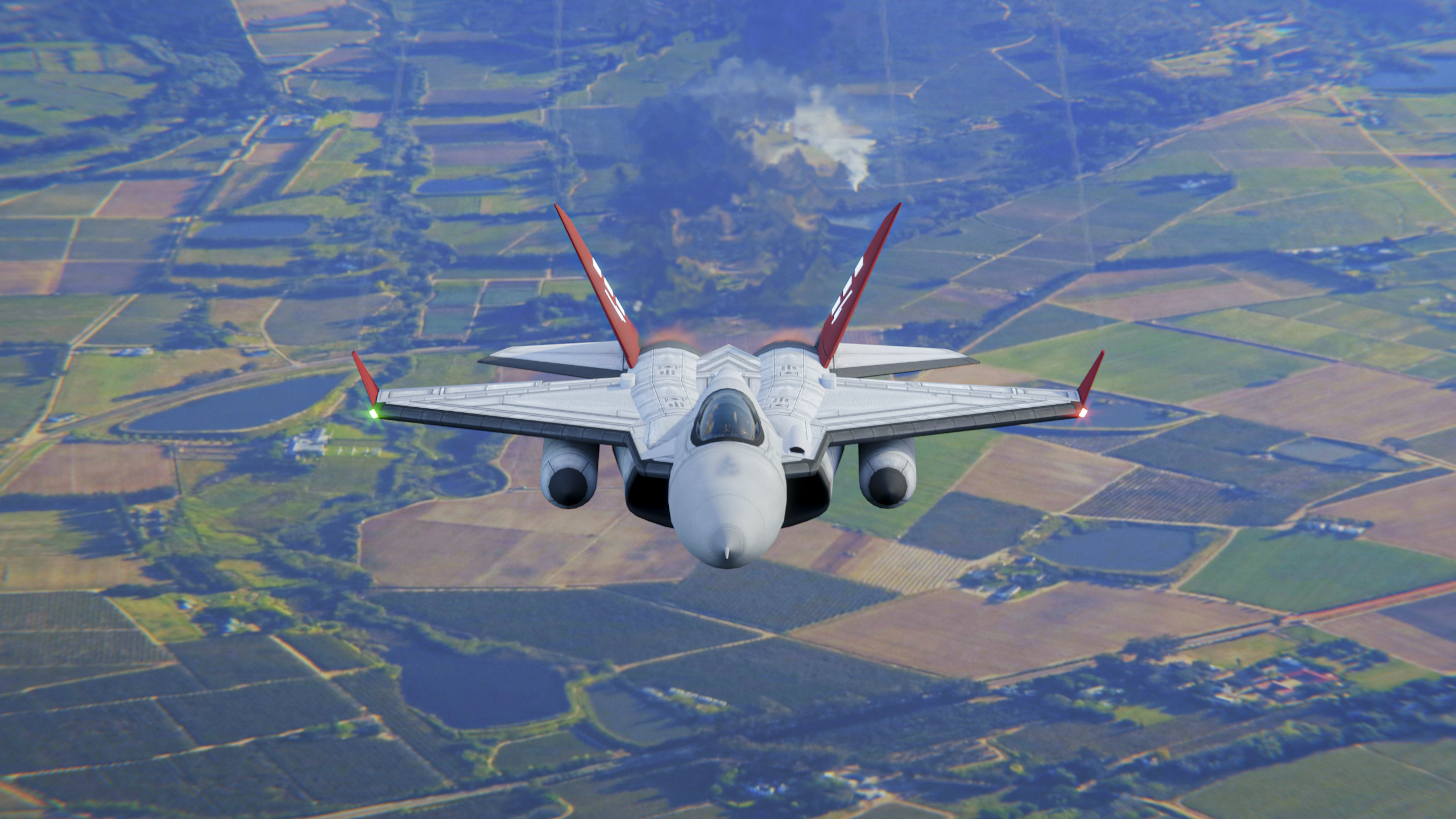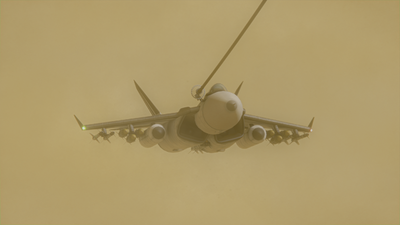F-77 Shrike
|
F-77
Sparrow Aeronautics F-77 Shrike
|
|||||
|---|---|---|---|---|---|
| Air superiority fighter | |||||
 |
|||||
| A Block 95 F-77 Shrike (A035-71) from the 53rd Tactical Fighter Squadron “Ronin” (TF-53) in flight. This airframe was one of the few to be converted from the original Block 5 model all the way to the final Block 95 specification. | |||||
| National Origin | Aquaria | ||||
| Production History | |||||
| Designed | |||||
| August 31st 2066 - December 4th 2069 | |||||
| Produced | |||||
| February 12th 2068 - January 6th 2115 | |||||
| Designer | Sparrow Aeronautics | ||||
| Unit Cost | 908,000 Aquarian Kerbits(√) | ||||
| Number Built | 203 | ||||
| Service History | |||||
| In Service | |||||
| April 3rd, 2070 - January 25th, 2115 | |||||
| Used By | Aquaria | ||||
| Aircraft Characteristics | |||||
| Dry Mass | 4891 kg | ||||
| Length | 11.66 m | ||||
| Width | 8.39 m | ||||
| Height | 3.36 m | ||||
| Propulsion | 2x Corain Motors J304 Afterburning Turbofan engines | ||||
| Operational Range | 540 km | ||||
| Crew | One Pilot | ||||
The Sparrow Aeronautics F-77 Shrike was an all-weather, twin-engine, single-seat 5th generation air superiority fighter designed and produced by Sparrow Aeronautics and used by the Aquarian Air Force. Initially developed as a purely air-to-air platform, the aircraft operated as the mainline tactical and multirole fighter of the Republic of Aquaria for over 35 years.
Development
Failed Replacement and Financial Controversy
When originally envisioned, the F-77 was planned to serve into the latter half of the 2080s at the latest, before being replaced by a more advanced future aircraft. By 2081 however, the Shrike, bolstered by several incremental upgrades, was still performing up to par with rivals, and the hunt for its successor in the TSF-X program was facing rampant delays and setbacks. Despite the public unveiling of a prototype, a functional aircraft never emerged from its development.
The failure of the TSF-X competition was a much publicised disaster for the Aquarian Air Force, and led to the branch coming under much greater government scrutiny in its wake. When it became clear that funding to pursue another new aircraft design in the near future would not materialise, the AQAF hunkered down and settled for another round of major fleet upgrades. The introduction of the new much revised Block 85 model, when bundled with a multi-year contract to conduct a rolling refit and rejuvenation of the fleet and add a further 9,000 flight hours to most airframes, tipped the F-77 into becoming the most expensive military program in Aquaria’s history.
Officially packaged as the “Mid-Life Service Extension Program”, the plan sparked some outrage amongst those who viewed the jet as already due for retirement. In one address, Councillor Lambchop Kerman branded it:
| “ | an eleventh-hour… …floundering attempt at damage control, that could undermine our security for a decade or longer. | ” |
| —Lambchop Kerman | ||
, and even coined slogans such as “Don’t Invest in Yesterday’s Best” in reference to the contract.
Nevertheless, the move proved a success for both the Air Force and the Treasury, providing a significant leap in capability for its pilots while remaining quite economical in the face of developing and procuring all new, unproven aircraft. The global recession in the aftermath of the 2091-2092 Second Great Kerbin War combined with the seemingly reduced threat of the Sarconian Insurgency would later dispel talk of restarting TSF-X or embarking on a similar competition for a next-generation fighter, paving the way for the Shrike to continue well into the 22nd century.
Design
The Shrike has a tailed compound delta wing structure with canted wingtips and a pair of vertical stabilisers. It is powered by a pair of Corain Motors J304 Afterburning Turbofan jet engines, each providing up to approximately 84,000N of thrust dry and 139,000N wet. They are fed by two adjustable ramp intakes mounted underneath wing strakes, next to the cockpit.
Early variants stored their weaponry exclusively on wing mounted pylons, with up to 6 individual hardpoints. Starting with the Block 80 major refit, they were wholly relocated to an internal bay within the fuselage of the aircraft to minimise its radar signature, and the wing pylons became an optional feature of its loadout. It was also armed with a single 20mm Vulcan Autocannon, which would be moved from a central position underneath the nose to the left shoulder above the intake later in its life. Initially only rated for use with the AIM-9 Sidewinder and AIM-120 AMRAAM air to air missiles, over its lifetime, the Shrike eventually achieved compatibility with every missile, bomb, and drop tank type in service with the AQAF.
While possessing its own electronic warfare suite for much of its service, beginning in 2082 trials were conducted using some modified two seater training aircraft in conjunction with external electronic jamming pods. These were nicknamed 'Static Shrikes' or just 'Statics' by their pilots and other airmen due to their older generation engines and additional drag induced by the extra ECM equipment, as well as an audible crackling that could be heard over the radio during in flight communications to and from the planes. Despite promising performance, none of these variants were ever ordered or inducted into regular service.
The Shrike would pioneer a trend of larger glass cockpits in modern fighters over the following decades - when it entered service in 2070, the all-glass bubble canopy of the aircraft was almost twice the size by area than that of any other fighter on Kerbin. After the narrow and limiting field of view from the cockpit being one of foremost complaints surrounding the AQAF’s previous fighter aircraft, pilots compared the visibility afforded by the F-77 extremely favourably to its predecessor. Later in life it would receive an Indium reflective coating, a contested upgrade program which cost approximately 6,000 Kerbits per model which and questions within the Council about military expenditure in the wake of the Second Great Kerbin War.
Variants
'Static Shrike'
Beginning in 2082, trials were conducted using some modified two seater training F-77 airframes in conjunction with external electronic jamming pods. While never given an official designation, rthese were nicknamed 'Static Shrikes' or just 'Statics' by their pilots and other airmen due to their older generation engines and additional drag induced by the extra ECM equipment, as well as an audible crackling that could be heard over the radio during in flight communications to and from the planes. Despite promising performance, none of these variants were ever ordered or inducted into regular service.
Zaror Specification

Carrier Specification
Block 5
The original, baseline planes that first rolled out of the factory in 2070, the Block 5 looks very different to the Shrikes of today, and were not nearly as refined.
Block 50
By far the largest change between iterations, the Block 50 upgrade was rolled out over the course of months and required a near complete rebuild with hundreds of new components. This streamlined and lengthened the fuselage and cockpit, adjusted the flight surfaces, and increased the range and battery capacity. Though it was costly and greatly decreased the AQAF’s readiness when it was being carried out, the end result was an aircraft miles ahead of its predecessor. The general shape is very similar to a modern Shrike, the key differences being the intake shape and shorter LEX.
Block 60
The Block 60 improved on the 50 by lengthening the Leading Edge Extensions, resulting in increased agility at many speeds. It also came with slight avionics and software improvements.
Block 65
The Block 65 featured reshaped intakes, decreasing frontal RCS significantly and improving air flow at high speeds. It also introduced the CSPW, or Central Special Weapon, hardpoint. This allowed the Shrike to mount systems such as small railguns and fixed lasers.
Block 70
The Block 70 was produced after simulations with contemporary aircraft showed the FCS struggling to handle the turns at high G necessary, something which hadn’t been encountered to the same degree in the Sarconian Counterinsurgency. The upgrade was rolled out with a completely reworked next generation avionics and flight computer, flight surface self repair software, and a greatly modernised holographic and digital cockpit. The flight helmet was also reworked to increase situational awareness and streamline the HUD.
Block 80
The Block 80 brings a large visual change through a rework of the Shrike’s Leading Edge Wing Extensions, in a setup that increases manuverability, visibility, and ease of access to the cockpit. It also replaces the ageing radar with a new and more powerful version.
Operational History
Never intended to serve for so long, the Shrike was pressed into the role of Aquaria’s premier fighter aircraft for over three and a half decades, an absurdly long period compared to the Air Forces of its peers on the global stage.
The maintenance cost benefits of operating a single fleet for such a lengthy period are estimated to have saved the AQAF millions. By the end of its lifetime, despite being significantly larger and more capable, the flyaway cost of a Shrike had actually decreased by nearly 25%, not accounting for minimal inflation.

